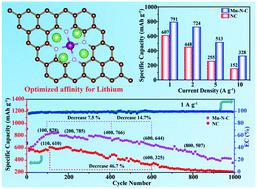当前位置:
X-MOL 学术
›
Mater. Chem. Front.
›
论文详情
Our official English website, www.x-mol.net, welcomes your
feedback! (Note: you will need to create a separate account there.)
Atomically dispersed metal sites anchored in N-doped carbon nanosheets with enhanced Li storage performance
Materials Chemistry Frontiers ( IF 6.0 ) Pub Date : 2020-05-26 , DOI: 10.1039/d0qm00191k Mengwei Yuan 1, 2, 3, 4, 5 , Zemin Sun 1, 2, 3, 4, 5 , Liu Lin 1, 2, 3, 4, 5 , Han Yang 1, 2, 3, 4, 5 , Di Wang 1, 2, 3, 4, 5 , Kuibo Yin 6, 7, 8, 9, 10 , Caiyun Nan 1, 2, 3, 4, 5 , Genban Sun 1, 2, 3, 4, 5 , Huifeng Li 1, 2, 3, 4, 5 , Shulan Ma 1, 2, 3, 4, 5
Materials Chemistry Frontiers ( IF 6.0 ) Pub Date : 2020-05-26 , DOI: 10.1039/d0qm00191k Mengwei Yuan 1, 2, 3, 4, 5 , Zemin Sun 1, 2, 3, 4, 5 , Liu Lin 1, 2, 3, 4, 5 , Han Yang 1, 2, 3, 4, 5 , Di Wang 1, 2, 3, 4, 5 , Kuibo Yin 6, 7, 8, 9, 10 , Caiyun Nan 1, 2, 3, 4, 5 , Genban Sun 1, 2, 3, 4, 5 , Huifeng Li 1, 2, 3, 4, 5 , Shulan Ma 1, 2, 3, 4, 5
Affiliation

|
The topological structure of carbon materials for lithium storage performance is an active issue in energy resources. However, the low specific capacity of carbon materials limits their application in the rapidly developing market, although they have the highest marginal value. Herein, we develop a facile method for scaled-up production of materials with atomically dispersed metal sites anchored on nitrogen-enriched carbon nanosheets (M–N–C), including nickel, iron and manganese metal sites. This is the first time that low-cost atomically dispersed M–N–C has been used to enhance Li storage performance. The anchoring of the atomically dispersed metal sites effectively improves the extent of carbonization and optimizes the electronic structure, which enhances the conductivity and accelerates the adsorption kinetics for Li+; this results in high capacity and superior rate performance. In the case of Mn–N–C, it presents an ultrahigh specific capacity of 500 mA h g−1 at 1 A g−1 after 1000 cycles. The atomically dispersed materials also demonstrate satisfactory rate performance, with an extremely high specific capacity of 328 mA h g−1 at 10 A g−1; this is greatly superior to that of N-doped carbon nanosheets (<200 mA h g−1). Similarly, the Ni–N–C and Fe–N–C nanosheet materials display excellent performance in Li storage. These results suggest that this strategy will open a new path for the design of alkali ion storage materials and provide new insight into the relationship between the topological structures of carbon materials and their alkali ion storage performance.
中文翻译:

原子分散的金属位点锚固在N掺杂的碳纳米片中,具有增强的Li存储性能
用于锂存储性能的碳材料的拓扑结构是能源中的一个重要问题。然而,尽管碳材料的边际价值最高,但其低比容量限制了它们在快速发展的市场中的应用。在此,我们开发了一种简便的方法,用于按规模生产具有原子分散的金属位点的材料,这些金属位点锚定在富氮碳纳米片(M–N–C)上,包括镍,铁和锰金属位点。这是首次使用低成本原子分散的M–N–C来增强Li的存储性能。原子分散的金属位点的锚固有效地改善了碳化程度并优化了电子结构,从而增强了电导率并加速了对Li +的吸附动力学; 这导致高容量和出色的速率性能。在Mn–N–C的情况下,经过1000次循环后,在1 A g -1下呈现500 mA hg -1的超高比容量。原子分散的材料还显示出令人满意的速率性能,在10 A g -1下具有328 mA hg -1的极高比容量;这大大优于N掺杂的碳纳米片(<200 mA hg -1)。同样,Ni–N–C和Fe–N–C纳米片材料在锂存储中显示出出色的性能。这些结果表明,该策略将为碱金属离子存储材料的设计开辟新途径,并为碳材料的拓扑结构与其碱金属离子存储性能之间的关系提供新的见解。
更新日期:2020-07-02
中文翻译:

原子分散的金属位点锚固在N掺杂的碳纳米片中,具有增强的Li存储性能
用于锂存储性能的碳材料的拓扑结构是能源中的一个重要问题。然而,尽管碳材料的边际价值最高,但其低比容量限制了它们在快速发展的市场中的应用。在此,我们开发了一种简便的方法,用于按规模生产具有原子分散的金属位点的材料,这些金属位点锚定在富氮碳纳米片(M–N–C)上,包括镍,铁和锰金属位点。这是首次使用低成本原子分散的M–N–C来增强Li的存储性能。原子分散的金属位点的锚固有效地改善了碳化程度并优化了电子结构,从而增强了电导率并加速了对Li +的吸附动力学; 这导致高容量和出色的速率性能。在Mn–N–C的情况下,经过1000次循环后,在1 A g -1下呈现500 mA hg -1的超高比容量。原子分散的材料还显示出令人满意的速率性能,在10 A g -1下具有328 mA hg -1的极高比容量;这大大优于N掺杂的碳纳米片(<200 mA hg -1)。同样,Ni–N–C和Fe–N–C纳米片材料在锂存储中显示出出色的性能。这些结果表明,该策略将为碱金属离子存储材料的设计开辟新途径,并为碳材料的拓扑结构与其碱金属离子存储性能之间的关系提供新的见解。











































 京公网安备 11010802027423号
京公网安备 11010802027423号